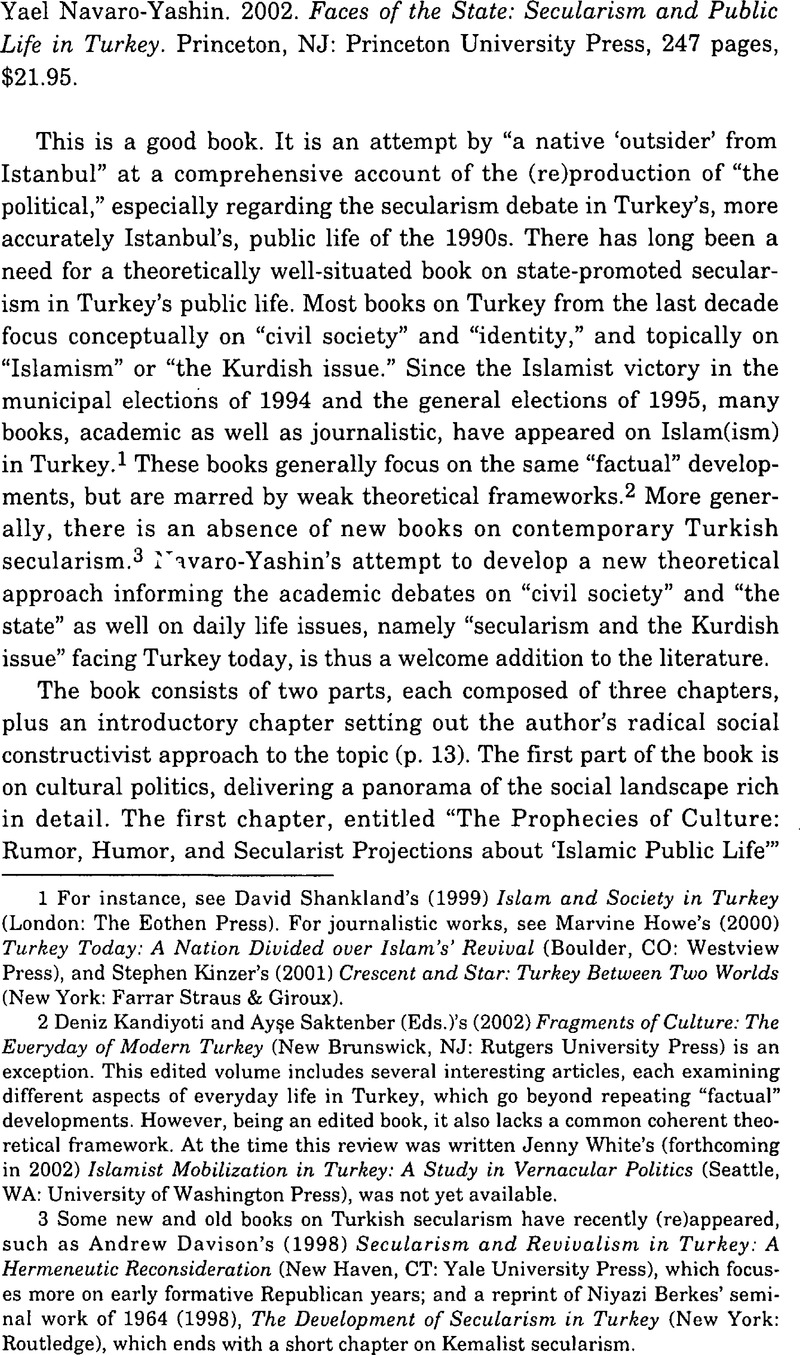Published online by Cambridge University Press: 21 July 2015

1 For instance, see Shankland's, David (1999) Islam and Society in Turkey (London: The Eothen Press)Google Scholar. For journalistic works, see Howe's, Marvine (2000) Turkey Today: A Nation Divided over Islam's’ Revival (Boulder, CO: Westview Press)Google Scholar, and Kinzer's, Stephen (2001) Crescent and Star: Turkey Between Two Worlds (New York: Farrar Straus & Giroux)Google Scholar.
2 Kandiyoti, Deniz and Saktenber, Ayşe (Eds.)'s (2002) Fragments of Culture: The Everyday of Modern Turkey (New Brunswick, NJ: Rutgers University Press)Google Scholar is an exception. This edited volume includes several interesting articles, each examining different aspects of everyday life in Turkey, which go beyond repeating “factual” developments. However, being an edited book, it also lacks a common coherent theoretical framework. At the time this review was written White's, Jenny (forthcoming in 2002) Islamist Mobilization in Turkey: A Study in Vernacular Politics (Seattle, WA: University of Washington Press)Google Scholar, was not yet available.
3 Some new and old books on Turkish secularism have recently (re)appeared, such as Davison's, Andrew (1998) Secularism and Revivalism in Turkey: A Hermeneutic Reconsideration (New Haven, CT: Yale University Press)Google Scholar, which focuses more on early formative Republican years; and a reprint of Berkes', Niyazi seminal work of 1964 (1998), The Development of Secularism in Turkey (New York: Routledge)Google Scholar, which ends with a short chapter on Kemalist secularism.
4 Following Anderson's, Benedict famous work (1983), Imagined Communities: Reflections on the Origins and Spread of Nationalism (London: Verso)Google Scholar, Kitromilides explains how these groups were turned into “Greeks.” See Kitromilides, Paschalis M. (1989), “‘Imagined Communities’ and the Origins of the National Question in the Balkans,” European History Quarterly, 19, especially pp. 169–177CrossRefGoogle Scholar. See also Dimitras, Panayote Ellias (2000), “Writing and Rewriting of History in the Context of Balkan Nationalism,” Southern European Politics, 1(1), p. 42Google Scholar.
5 Gershom Scholem (1971), “The Crypto-Jewish Sect of the Dönmeh (Sabbatians) in Turkey,” in idem, The Messianic Idea of Judaism and Other Essays on Jewish Spirituality (New York: Schocken Books), p. 149. Translated from German by Michael A. Meyer, the article was originally a paper read at the Tenth Congress of the International Association for the History of Religions, Marburg, Germany, September 1960. Numen, VII (1960), pp. 93–122Google Scholar (in German). Navaro-Yashin quotes the reprinted paperback edition of 1995.
6 Scholem, Gershom, “The Crypto-Jewish Sect,” p. 151Google Scholar. For more on the Sabbatians, see Scholem, Gershom (1973, orig. in Hebrew, 1957), Sabbatai Şevi: The Mystical Messiah, trans. Werblowsky, R. J. Zwi (Princeton, NJ: Princeton University Press)Google Scholar.